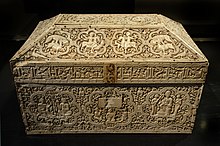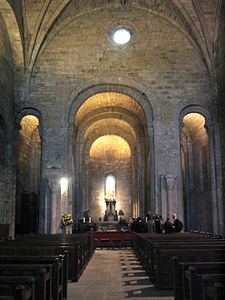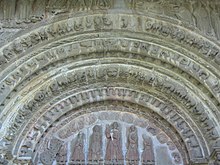San Salvador de Leyre Monastery
| San Salvador de Leyre Monastery | |
|---|---|
 Apse of the monastery church of Leyre |
|
| location |
region |
| Coordinates: | 42 ° 38 '7 " N , 1 ° 10' 18" W |
| Serial number according to Janauschek |
671 |
| founding year | unknown |
| Cistercian since | 1230 |
| Year of dissolution / annulment |
1270 |
| Year of repopulation | 1273 |
| Year of re-dissolution | 1836 |
| Mother monastery | La Oliva Monastery (Navarre) |
| Primary Abbey | Morimond Monastery |
The monastery of San Salvador de Leyre was the oldest monastery in the northern Spanish region of Navarre . It is an important Romanesque monument and has been used as a monastery again since 1954 by the Benedictines .
Geographical location
The monastery is located about 50 km southeast of Pamplona in the municipality of Yesa at the foot of the Pyrenees above the Aragón valley on a rock on the slope of the Sierra de Leire .
history

The year the monastery was founded is unknown. The oldest surviving mention is a letter of November 15, 851 from Saint Eulogius of Cordoba to Wilesindo , Bishop of Pamplona , in which he remembers a visit there. Older traces are also not proven archaeologically . Around 860 the monastery received the relics of Saints Nunilo and Alodia, which were kept in the "Caliph's box", today in the Museo de Navarra in Pamplona.
The three first kings of Pamplona , Íñigo Arista († 851/852), García Íñiguez († 882) and Fortún Garcés († after 905), were buried in San Salvador de Leyre.
After the devastation of Pamplona by Abd ar-Rahmans III. 924, the monastery served until 1023 as a bishop's seat of the diocese and as a result were abbots of Leyre often in personal union also bishops of Pamplona. From around 1030 the monastery opened to the Cluniac reform . The monastery was also temporarily the residence of the King of Navarre and served as their burial place. Structural evidence from this period has not been preserved. A message about the consecration of the church - presumably the choir - is for the year 1057 before a second corresponding message for October 24, 1098, now probably for the completed western part. In the following years there was an increasing dispute between the Bishop of Pamplona and the very rich monastery. At that time the monastery was subordinate to 58 villages and 71 churches and monasteries. The increasing flow of pilgrims on the Way of St. James created additional income.
With the transition to the Cistercian order in 1230, the monastery subordinated itself to the mother monastery La Oliva from the filiation of the primary abbey of Morimond . In 1270 the Benedictines regained the monastery, but could only hold it until 1273, when they were again replaced by the Cistercians.
During the Desamortización , the Spanish monasteries were dissolved and the Cistercians were expelled from Leyre in 1836. In 1863 the remains of the early kings of Navarre were moved to another location as they were not safe in the abandoned monastery. They did not finally return to Leyre until 1915 and have since rested in a shared sarcophagus on the north wall of the church. In 1945 the government handed over the facility to the Benedictines from Solesmes, France . The Benedictines took care of the renovation of the now dilapidated complex and resumed the practice of Gregorian choral singing .
building
crypt
The crypt of the monastery church of Santa María de Leyre , on whose vaults the choir rests and which was also the burial place of the kings of Navarre, dates back to the 9th century. Other dates are later, for example "before 1057". The mighty pillars of the crypt rest on column drums that are relatively thin in cross-section, a construction that is statically and functionally not meaningfully explained.
church
The choir of the church, built in Romanesque style , is also dated "before 1057". Archaeological findings indicate an originally three-aisled nave. When Navarre fell to Aragón in 1076, it lost its function as the center of the ruling dynasty - the kings of Aragón had a functionally similar "house monastery" with San Juan de la Peña - and construction work in Leyre largely came to a standstill.
The west portal from the first half of the 12th century was added, actually a template for a much larger church, which was then no longer built. In addition to Santa María la Real in Sangüesa , it is the most elaborate building sculpture that was created in north-east Spain in the Romanesque period, but of comparatively "provincial quality". In its present form, it appears as a collage made up of different parts that were only later put together. This is particularly clear in the tympanum , the figures of which - partly mutilated - were simply placed next to each other according to size. The western part of the church was - then already under the Cistercians - rebuilt in early Gothic forms by the 14th century , the division into naves was eliminated and the hall was vaulted with a single nave.
Other buildings
The cloister is no longer there. The abbey buildings date from the 17th and 18th centuries.
Monument protection
The complex has been a cultural monument ( Bien de Interés Cultural ) according to Spanish monument law since 1867 and is inscribed under the number (RI) - 51-0000007-00000 in the national register of architectural monuments.
Legends
Abbot San Virila is the most famous personality of the Leyre Monastery . During the Recreatio he is said to have pondered the question of whether the singing of the angels could be endured for all eternity without boredom. He thoughtfully listened to a nightingale singing . When he returned to the monastery, 300 years had passed and his blasphemous question had been answered with it, a modification of the legend of the dormouse .
Worth knowing
- In the monastery area there is a hotel and a restaurant, but no pilgrims' hostel .
- When the then Spanish heir to the throne, Philip (VI) , visited the monastery in 1993, he held the title of “Prince of Viana” ( Principe de Viana ) for the first time , which is only ever due to the heir to the throne of Navarre.
literature
- Dietrich Höllhuber and Werner Schäfke: The Spanish Way of St. James. History and art on the way to Santiago de Compostela . DuMont, [Cologne] 1999. ISBN 3-7701-4862-2
- NN: Leyre Monastery . [Leaflet]. Yesa, before 2019.
- Pedro de Palol et al. Max Hirmer: Spain. Art of the early Middle Ages from the Visigoth Empire to the end of the Romanesque period . Hirmer, Munich 1965.
- Werner Schäfke: Northwest Spain. Landscape, history and art on the way to Santiago de Compostela . DuMont, Cologne 1987. ISBN 3-7701-1589-9
- Pierre Tisné et al: Spain. Pictorial Atlas of Spanish Art . DuMont Schauberg, Cologne 1968. ISBN 3-7701-4461-9
Web links
- Site of the Benedictine Abbey of Leyre
- Werner Nolte's website on the Leyre Monastery
- Wilfried Stevens: The Abbot San Virila. onlinezeitung24.de, October 13, 2015
Individual evidence
- ^ Schäfke: Northwest Spain , p. 43.
- ^ NN: Leyre Monastery .
- ^ Schäfke: Northwest Spain , p. 43.
- ^ NN: Leyre Monastery .
- ^ NN: Leyre Monastery .
- ^ Schäfke: Northwest Spain , p. 43.
- ↑ Schäfke: Northwest Spain , p. 44.
- ^ Schäfke: Northwest Spain , p. 45.
- ^ Schäfke: Northwest Spain , p. 45.
- ^ Palol: Spain , p. 63.
- ↑ Höllhuber: The Spanish Way of St. James , p. 69.
- ↑ Höllhuber: The Spanish Way of St. James , p. 71.
- ↑ Höllhuber: The Spanish Way of St. James , p. 69; NN: Leyre Monastery ; Beate Schümann: Chants in the Silence . In: Die Welt from December 21, 2006; accessed on May 4, 2019.
- ↑ Tisné: Spain , S. 260th
- ↑ Höllhuber: Der spanische Jakobsweg , p. 69, similar to Schäfke: Nordwest-Spanien , p. 44.
- ↑ See: Schäfke: Nordwest-Spanien , p. 44.
- ↑ Höllhuber: The Spanish Way of St. James , p. 69.
- ↑ Höllhuber: The Spanish Way of St. James , p. 70.
- ↑ Höllhuber: The Spanish Way of St. James , p. 70; more positive evaluation by: Tisné: Spain , p. 260; In Kingsley Porter's standard work: Romanesque Sculpture of the Pilgrimage Roads . 3 volumes. Hacker Arts Books, New York, reprinted 1969, does not even mention the portal.
- ↑ Höllhuber: The Spanish Way of St. James , p. 71; Schäfke: Northwest Spain , p. 46.
- ↑ Höllhuber: The Spanish Way of St. James , p. 71; Schäfke: Northwest Spain , p. 44.
- ^ Palol: Spain , p. 63.
- ↑ Höllhuber: The Spanish Way of St. James , p. 71; Schäfke: Northwest Spain , p. 46.
- ↑ Entry in the list of monuments .
- ^ Schäfke: Nordwest-Spanien , p. 46; NN: Leyre Monastery .
- ^ Website of the Benedictine Abbey of Leyre .
- ↑ Höllhuber: The Spanish Way of St. James , p. 71.





